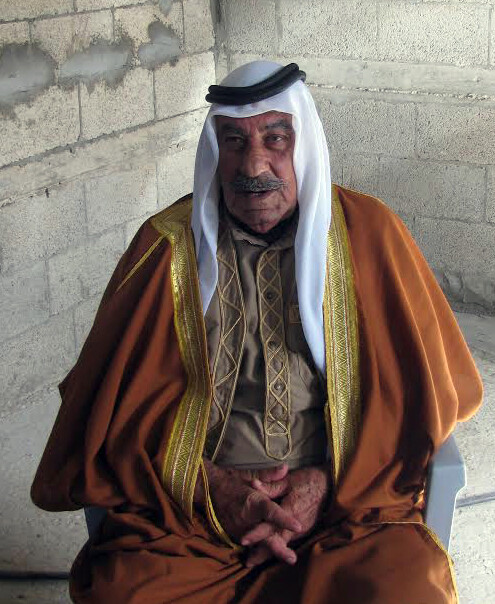The Electronic Intifada Gaza Strip 5 December 2013

Hassan Ali al-Khaldi is head of his family in al-Bureij refugee camp.
In many houses across Gaza, a space has been reserved for men from the same extended family to gather each day for conversations and games of cards and, on occasions, the settling of disputes. Known as the diwan in Arabic, this space reflects a patriarchal custom that stretches back hundreds of years.
Hassan Ali al-Khaldi — or Abu Bahjat, as he is known — is the head of his clan in al-Bureij refugee camp in central Gaza. A 78-year-old retired police officer, he is originally from Karatiyya, a village in present-day Israel that is approximately 30 kilometers from the Strip.
Abu Bahjat and his parents were forced to flee their home by Zionist forces during the Nakba (Arabic for catastrophe) — the forced displacement of 750,000 Palestinians at the time of Israel’s establishment in 1948. He was 14 then.
Almost every day he sits in a newly-refurbished garage at the family’s house in al-Bureij and welcomes guests. His father, Ali, had similarly presided over a diwan.
Meals with British soldiers
According to Abu Bahjat the diwan in Karatiyya enjoyed a good relationship with the British Mandate authorities ruling Palestine between 1923 and 1948. High-ranking British soldiers were even known to join the men of his family for meals.
“I recall very well that the British authorities respected our habits of solving disputes,” Abu Bahjat said. “In one dispute, the British authorities detained some suspects until the diwan — led by my father and the heads of other nearby families — resolved it.”
The police in Gaza similarly refer many cases to the diwan today.
“Our society is tribal and tradition-based,” said Abu Yousef al-Baghdadi, a former mayor of al-Bureij. “I remember that a few years after the Palestinian Authority was set up, Yasser Arafat ordered the establishment of a department called the Department of Tribal Affairs. Now this department is no longer functioning, but replaced by conciliation committees all over the Gaza Strip.”
The roots of the diwan can be traced back for hundreds of years, according to historian Dr. Naser al-Yafawi. “In older times, diwans were made of straw and then from mud and they remained so until 1948.
“Yet in Palestinian cities and towns prior to 1948, there used to be one big family house, made of bricks, for all the families in the same city. In Jaffa, for example, there was the diwan of the Abu Keshk family, where most of the issues of their neighbors were addressed.”
Al-Yawafi added that the traditional role of the diwan was to achieve reconciliation when fighting broke out between tribes. “The Bedouin parts of Palestine were the most famous for spread of diwans or tribal chairmen, the first of which was the Nabaheen diwan in the Naqab [Negev] dessert.”
Determined to continue
Hassan Jaber, a journalist living in al-Bureij, said the diwan custom has survived despite the spread of alternative social outlets such as coffee shops and restaurants.
“It goes without saying that the traditional status of the diwan has been downgraded,” he added. “And the significance of the diwan’s chief has been affected by community developments, such as the growth in population. In recent times, similar gatherings have emerged that don’t necessarily involve members of the same family but rather people with the same ideology or political orientation.”
Nonetheless, many Palestinian men seem determined to keep on handing down the diwan custom from one generation to the next. Safwat al-Khaldi, Abu Bahjat’s 52-year-old son, expects to lead a diwan after his father is no longer able to do so.
Safwat said: “Without the diwan, we are not going to be able to defuse growing social problems in our tribal society that remains under occupation.”
Rami Almeghari is a journalist and university lecturer based in the Gaza Strip.




